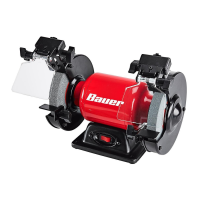Page 12 For technical questions, please call 1-888-866-5797. Item 57286
SAFETY OPERATION MAINTENANCESETUP
Troubleshooting
Problem Possible Causes Likely Solutions
Tool will not start. 1. Cord not connected.
2. No power at outlet.
3. Tool’s thermal reset breaker
tripped (if equipped).
4. Internal damage or wear. (Carbon
brushes or switch, for example.)
1. Check that cord is plugged in.
2. Check power at outlet. If outlet is unpowered,
turn off tool and check circuit breaker.
If breaker is tripped, make sure circuit is right
capacity for tool and circuit has no other loads.
3. Turn off tool and allow to cool. Press reset button on tool.
4. Have technician service tool.
Tool operates
slowly.
1. Forcing tool to work too fast.
2. Extension cord too long or
cord diameter too small.
1. Allow tool to work at its own rate.
2. Eliminate use of extension cord. If an extension
cord is needed, use one with the proper diameter for
its length and load. See Table A on page 3.
Performance
decreases
over time.
1. Accessory dull or damaged.
2. Carbon brushes worn or damaged.
1. Keep cutting accessories sharp. Replace as needed.
2. Have qualified technician replace brushes.
Excessive noise
or rattling.
Internal damage or wear. (Carbon
brushes or bearings, for example.)
Have technician service tool.
Overheating. 1. Forcing machine to work too fast.
2. Accessory dull or damaged.
3. Blocked motor housing vents.
4. Motor being strained by long or
small diameter extension cord.
1. Allow machine to work at its own rate.
2. Keep cutting accessories sharp. Replace as needed.
3. Wear ANSI-approved safety goggles and
NIOSH-approved dust mask/respirator while
blowing dust out of motor using compressed air.
4. Eliminate use of extension cord. If an extension cord
is needed, use one with the proper diameter for its
length and load. See Table A on page 3.
Tool does not
grind, sand or
brush effectively.
1. Disc accessory may be
loose on Spindle.
2. Disc accessory may be damaged,
worn or wrong type for the material.
1. Be sure disc accessory is of correct dimension
and Flange Arbor Nut is tight.
2. Check condition and type of disc accessory. Use only
proper type of disc accessory in good condition.
Grinding Wheels
do not spin true
1. Too much play in the Grinding
Wheel bushings.
2. Inner and / or Outer Flanges are
warped, damaged, or worn.
3. Arbor Nut is too tight.
1. Replace the bushings or install a new Grinding Wheel.
2. Replace Inner and / or Outer Flanges.
3. Loosen Arbor Nut. Do not overtighten.
Excessive
Grinding Wheel
vibration
1. Grinding Wheels not balanced.
2. Too much play in the Grinding
Wheel bushings.
3. Inner and / or Outer Flanges are
warped, damaged, or worn.
4. Incorrect type / size Wheel(s).
5. Worn Bearings in Bench Grinder.
1. Balance Grinding wheels and correct side to side
wobble as described in Correcting Wheel Balance and
″Eliminating Wheel Wobble (Side to Side)″ on page 9.
2. Replace the bushings or install a new Grinding Wheel.
3. Replace Inner and / or Outer Flanges.
4. Use correct type / size Wheel(s) as described under
″Replacing a Grinding Wheel″ on page 8
5. Have qualified technician replace bearings.
Follow all safety precautions whenever diagnosing or servicing the tool.
Disconnect power supply before service.

